يمكن أن يكون الشروع في الرحلة لتأسيس عمل مزدهر لتصليح الساعات أمرًا مثيرًا ومجزيًا، لا سيما في صناعة تسود فيها الدقة والحرفية والأناقة الخالدة.
ومع إمكانية الربحية المدفوعة بالطلب الدائم على خدمات صيانة وترميم الساعات، فإن هذه الصناعة الفريدة تقدم مجموعتها الخاصة من التحديات والفرص التي تميزها عن المشاريع الأخرى.
في هذا الدليل الشامل، سنناقش بعض الأشياء التي تحتاج إلى معرفتها حول إصلاح الساعة.
تبدأ هنا مغامرتك في صناعة الساعات - دعنا نكشف أسرار ضبط الوقت ونتقن فن إصلاح الساعات معًا!
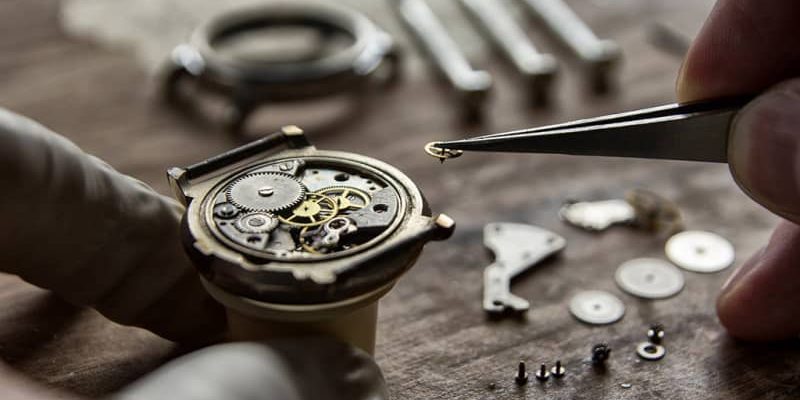
العلبة هي الغلاف الخارجي الواقي الذي يضم المكونات الداخلية للساعة وهو أمر بالغ الأهمية لكل من المظهر الجمالي والمتانة.
يمكن تصنيع العلب من مجموعة متنوعة من المواد، ولكل منها مجموعة من المزايا والملاءمة لأنواع مختلفة من الساعات.
تشمل المواد الشائعة الفولاذ المقاوم للصدأ والذهب والتيتانيوم والبلاستيك.
يحظى الفولاذ المقاوم للصدأ بشعبية كبيرة نظرًا لقدرته على تحمل التكاليف، وهو عبارة عن سبيكة مقاومة للتآكل توفر المتانة والقوة.
الفولاذ المقاوم للصدأ 316L هو سبيكة قياسية صناعية شائعة الاستخدام في العديد من التطبيقات بما في ذلك الساعات وصناعة الأغذية والمجال الطبي والبيئات المائية والبحرية.
وهو معروف بمقاومته للصدأ والتآكل، ومن هنا شعبيته.
في مجتمع الساعات، تتميز رولكس باستخدامها للفولاذ 904L، الذي قدمته في عام 1985، مما يجعلها أول شركة مصنعة لساعات اليد تتبنى هذا النوع من الفولاذ.
اختارت رولكس الفولاذ 904L لقابليته المحسنة للتلميع ومقاومته الفائقة للتآكل، على الرغم من أنه أكثر صعوبة في الماكينة ويتطلب معدات متخصصة للتشكيل.
وبصرف النظر عن الساعات، يجد الفولاذ 904L استخدامًا واسع النطاق في الصناعات عالية التقنية والفضاء والصناعات الكيميائية نظرًا لخصائصه الاستثنائية المضادة للتآكل التي يمكن مقارنتها بالمعادن الثمينة.
تتحكم رولكس، في سعيها لتحقيق الجودة، في عملية تصنيع مكونات ساعتها الفولاذية 904L بالكامل.
الفرق الرئيسي بين 316 لتر و904 لتر يكمن في المحتوى العالي من النيكل والكروم، بالإضافة إلى إدراج النحاس في 904L.
أولئك الذين يعانون من حساسية النيكل قد يفضلون الساعات المصنوعة من التيتانيوم، على الرغم من أن كلا من 316L و904L يحتويان على النيكل.
علاوة على ذلك، إذا كنت ترغب في الحصول على لمسة نهائية أكثر لمعانًا، فمن المرجح أن تكون مستويات الكروم المرتفعة في الفولاذ 904L أكثر جاذبية لك.
إنه مثالي للساعات اليومية وتلك المصممة للرياضة أو الأنشطة الخارجية.
التيتانيوم أخف وأقوى من الفولاذ المقاوم للصدأ، وهو مادة مضادة للحساسية ومثالية للأفراد ذوي البشرة الحساسة أو الذين يعانون من حساسية تجاه معادن معينة.
إن طبيعتها خفيفة الوزن تجعلها مناسبة للساعات الرياضية وساعات الطيران وغيرها من الساعات التي يكون فيها الوزن المنخفض أمرًا مرغوبًا فيه.
يعد الذهب خيارًا كلاسيكيًا للساعات الفاخرة، فهو يوفر إحساسًا لا لبس فيه بالهيبة والأناقة.
تتوفر العلب الذهبية بألوان مختلفة (الأصفر والأبيض والوردي)، وغالبًا ما تكون مخصصة للساعات الرسمية والساعات الراقية.
باعتباره أحد أندر المعادن وأكثرها قيمة، يُستخدم البلاتين في صناعة الساعات الفاخرة الأكثر تميزًا.
إنه متين للغاية ومقاوم للتشويه، مما يجعله خيارًا ممتازًا لساعات الإرث وعناصر هواة الجمع الراقية.
ال يتصل، المعروف أيضًا باسم وجه الساعة، يعرض الوقت وأي ميزات إضافية مثل وظائف التاريخ أو الكرونوغراف.
يمكن تصنيع الميناء من مواد مختلفة، بما في ذلك المعدن والمينا وعرق اللؤلؤ وحتى الأحجار الكريمة.
يمكن أن يؤثر اختيار المادة على المظهر الجمالي العام للساعة، حيث تتميز بعض الأقراص بتصميمات أو أنماط معقدة تضيف اهتمامًا بصريًا وتعزز جاذبية الساعة.
يشير المؤشر، الذي يشار إليه عادةً باسم عقارب الساعة، إلى الساعات والدقائق وأحيانًا الثواني على القرص.
يمكن تصنيعها من مواد مثل النحاس أو الفولاذ المقاوم للصدأ أو حتى الذهب، وغالبًا ما تكون مطلية بطلاء مضيء لتحسين الرؤية في ظروف الإضاءة المنخفضة.
يمكن أن يختلف نمط وتصميم المؤشرات بشكل كبير، بدءًا من الأيدي البسيطة وحتى الأشكال الأكثر تفصيلاً، اعتمادًا على التصميم العام للساعة.
الحركة هي قلب الساعة، وهي المسؤولة عن حفظ الوقت وتشغيل أي تعقيدات إضافية.
هناك نوعان أساسيان من الحركات: الميكانيكية والكوارتز.
يتم تشغيل الحركات الميكانيكية بواسطة نابض رئيسي وتتكون من العديد من التروس والمكونات التي تعمل معًا لتنظيم ضبط وقت الساعة.
من ناحية أخرى، تعمل حركات الكوارتز بالبطارية وتستخدم كريستال الكوارتز المهتز للحفاظ على دقة الوقت.
يعتمد الاختيار بين الحركات الميكانيكية وحركات الكوارتز على التفضيل الشخصي والميزانية ومستوى الصيانة المطلوب.
تلعب الأجزاء الزنبركية دورًا حاسمًا في وظيفة الساعات الميكانيكية. يقوم النابض الرئيسي، الذي يخزن الطاقة عند التعبئة، بتشغيل الساعة من خلال تحرير توترها تدريجيًا.
يعمل نابض التوازن، المعروف أيضًا باسم النابض الشعري، جنبًا إلى جنب مع عجلة التوازن لتنظيم ضبط وقت الساعة.
تتطلب هذه المكونات الدقيقة هندسة دقيقة وعادة ما تكون مصنوعة من مواد مثل Nivarox أو السيليكون، والتي توفر استقرارًا معززًا ومقاومة للتغيرات في درجات الحرارة والمجالات المغناطيسية.
تعتبر التروس مكونات أساسية في حركة الساعة، وهي مسؤولة عن نقل الطاقة من النابض الرئيسي إلى المكونات المختلفة التي تتحكم في ضبط الوقت والتعقيدات.
عادةً ما تكون التروس مصنوعة من النحاس أو المعادن المتينة الأخرى، ويجب أن يتم تصنيعها وتجميعها بدقة لضمان التشغيل السلس والحفاظ على الوقت الدقيق.
في الساعات الفاخرة الراقية، قد يتم تشطيب التروس يدويًا أو تزيينها لإظهار مهارة صانع الساعات واهتمامه بالتفاصيل.
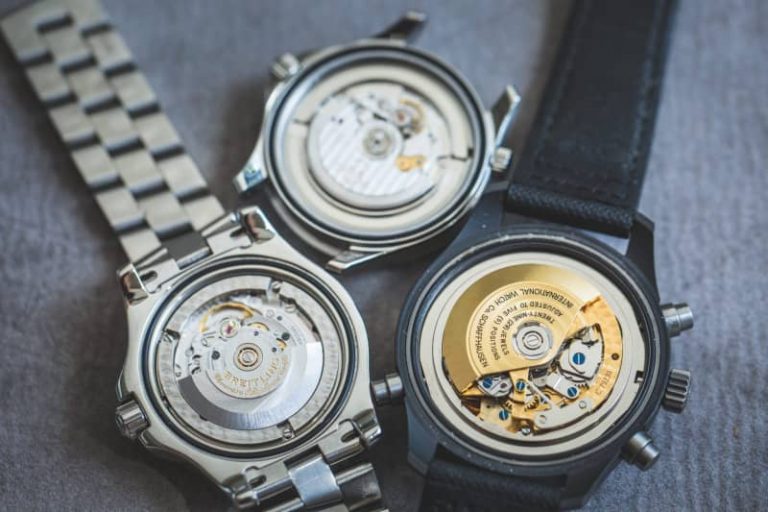
بشكل عام، يمكن تصنيف حركات الساعة إلى نوعين أساسيين: ميكانيكية وإلكترونية.
لقد صمدت الحركات الميكانيكية أمام اختبار الزمن باعتبارها نبضات القلب الموقرة للساعات التقليدية، التي يعود تاريخها إلى القرن الثامن عشر.
تشكل هذه الآليات الرائعة العمود الفقري للساعات، حيث تستخدم نابضًا رئيسيًا كمصدر للطاقة لتشغيل الأعمال الداخلية المعقدة.
ومن خلال التفاعل الدقيق بين التروس والرافعات والمكونات الأخرى المصنوعة بدقة، تضمن هذه الحركات حفظ الوقت بدقة ودقة.
تشتهر الحركات الميكانيكية بالحرفية والفنية، وهي تجسد قمة التميز في صناعة الساعات وغالباً ما ترتبط بالساعات الفاخرة.
ويمكن تصنيفها كذلك إلى ثلاث فئات رئيسية:
سواء أكنت تتعجب من التروس المعقدة أو تقدر السيمفونية الميكانيكية بداخلها، فإن الحركات الميكانيكية تقدم مزيجًا آسرًا من التقاليد والبراعة الهندسية والأناقة الخالدة.
تُظهر الحركات الميكانيكية التي يحركها الوزن، والمعروفة أيضًا بالساعات التي يحركها الوزن، الاندماج الرائع بين الهندسة الميكانيكية وفن صناعة الساعات.
تعتمد أجهزة ضبط الوقت الجذابة هذه على قوة الجاذبية لتشغيل آلياتها المعقدة.
يوفر نظام الأوزان، الذي يكون عادةً على شكل أقراص نحاسية أو حديدية ثقيلة، الطاقة اللازمة لقيادة تروس الساعة ورافعاتها وميزانها.
ومع انخفاض الأوزان تدريجيًا، يتم تحويل الطاقة الكامنة المخزنة إلى حركة ميكانيكية، مما يؤدي إلى تنسيق القياس الدقيق للوقت.
غالبًا ما تتميز هذه الساعات بالبندول أو عجلة التوازن كعنصر منظم، مما يضمن ضبط الوقت بشكل دقيق ومتسق.
تشتهر الحركات الميكانيكية التي تعتمد على الوزن بجاذبيتها البصرية الساحرة، حيث يضفي البندول المتأرجح أو التذبذب الإيقاعي لعجلة التوازن سحرًا ساحرًا على أي مساحة.
تقدم هذه الساعات الآسرة، التي تذكرنا بحقبة ماضية، لمحة عن إتقان حرفية صناعة الساعات وتكون بمثابة تذكير ببراعة وفن الهندسة الميكانيكية.
الساعات الزنبركية هي نوع من حركة الساعة الميكانيكية التي تستخدم قوة زنبرك ملفوف بإحكام لتشغيل أعماله الداخلية المعقدة.
ومع تحرر الطاقة المخزنة في النابض الرئيسي تدريجيًا، فإنها تقوم بتشغيل نظام معقد من التروس والرافعات ومكونات ميزان الساعة التي تنظم في النهاية دقة ضبط الوقت.
كانت هذه الآليات الجذابة موجودة منذ القرن السابع عشر ولا تزال تحظى بشعبية اليوم بسبب جاذبيتها البصرية الساحرة وأناقتها الخالدة.
من ساعات الحائط التقليدية إلى ساعات اليد الفاخرة، توفر الساعات النابضية مزيجًا ساحرًا من البراعة الهندسية والحرفية وفن صناعة الساعات.
أحدثت الحركات الإلكترونية ثورة في عالم ضبط الوقت بفضل وظائفها الدقيقة والموثوقة.
على عكس الحركات الميكانيكية التقليدية، تعتمد الحركات الإلكترونية على مكونات إلكترونية، مثل بلورات الكوارتز والدوائر المتكاملة، لقياس الوقت وتنظيمه.
تستخدم حركات الكوارتز الإلكترونية، الموجودة عادة في ساعات الكوارتز، التذبذبات الطبيعية لكريستال الكوارتز لضمان الدقة.
عندما يتم تطبيق تيار كهربائي على البلورة، فإنها تهتز بتردد محدد، مما يولد مرجعًا زمنيًا دقيقًا.
يتم بعد ذلك تحويل هذه الاهتزازات إلى نبضات كهربائية منتظمة، تعمل على تشغيل آلية ضبط الوقت في الساعة.
توفر الحركات الإلكترونية العديد من المزايا، بما في ذلك الدقة الاستثنائية ومتطلبات الصيانة المنخفضة والقدرة على تحمل التكاليف.
كما أنها مسؤولة عن انتشار شاشات العرض الرقمية، مما يسمح بسهولة القراءة وميزات إضافية مثل أجهزة ضبط الوقت وأجهزة الإنذار.
علاوة على ذلك، مهدت الحركات الإلكترونية الطريق للتقدم في الساعات الذكية، ودمج وظائف متطورة مثل تتبع اللياقة البدنية، والإشعارات، والاتصال بالأجهزة الأخرى.
بفضل دقتها التكنولوجية وتعدد استخداماتها، تستمر الحركات الإلكترونية في تشكيل المشهد الحديث لحفظ الوقت، مما يوفر مزيجًا من الراحة والدقة.
تستخدم حركات الكوارتز بلورة كوارتز تهتز للحفاظ على ضبط الوقت.
تشتهر حركات الكوارتز بدقتها القوية، مما يجعلها خيارًا مثاليًا لتطبيقات ضبط الوقت حيث تكون الدقة أمرًا بالغ الأهمية.
على عكس الحركات الميكانيكية، لا تعتمد حركات الكوارتز على قوة الجاذبية أو شد النابض الرئيسي لدفع آلياتها.
وبدلاً من ذلك، يستخدمون مذبذبًا إلكترونيًا على شكل بلورة كوارتز لتنظيم الأعمال الداخلية للحركة.
عندما يتم تطبيق تيار كهربائي على بلورة الكوارتز، فإنها تهتز بتردد معين وتولد نبضات كهربائية منتظمة تدفع آلية ضبط الوقت في الساعة.
تظل هذه الإشارة الإلكترونية مستقرة ومتسقة حتى في ظل درجات الحرارة ومستويات الضغط المختلفة، مما يجعل من الممكن تحقيق دقة زمنية دقيقة للغاية تصل إلى 0.001 ثانية في اليوم.
بالإضافة إلى دقتها الاستثنائية، تتطلب حركات الكوارتز أيضًا صيانة منخفضة جدًا مقارنة بالحركات الميكانيكية وبأسعار معقولة نسبيًا.
كما يسمح حجمها الصغير بمجموعة أكبر من التصاميم والأشكال، مما يجعل الساعات الحديثة أكثر جاذبية بصريًا ومفيدة من الناحية الوظيفية.
أحدث إدخال حركات الكوارتز ثورة في صناعة الساعات، مما سمح بالتقدم التكنولوجي مثل شاشات العرض الرقمية والميزات المتطورة مثل أجهزة ضبط الوقت أو الإنذارات.
بفضل أدائها الموثوق وتصميماتها الأنيقة، تظل ساعات الكوارتز تحظى بشعبية كبيرة بين عشاق الساعات اليوم وتستمر في تشكيل مستقبل تكنولوجيا ضبط الوقت.
تعد الحركات الرقمية أحدث تكرار في تكنولوجيا الساعات وتتميز بمجموعة متنوعة من الميزات غير المتوفرة مع حركات الكوارتز أو الحركات الميكانيكية.
وهي تستخدم مكونات رقمية، مثل الدوائر المتكاملة وشاشات الكريستال السائل، لقياس الوقت وعرضه بدقة.
توفر الساعات الرقمية العديد من المزايا مقارنة بالساعات التناظرية التقليدية.
على سبيل المثال، توفر قراءات أكثر دقة مع عدد أقل من الأجزاء المتحركة، بالإضافة إلى تحسين عمر البطارية وزيادة الوظائف.
يمكن تعزيز هذه الميزات بشكل أكبر من خلال دمج أجهزة الاستشعار التي تسمح بميزات أخرى مثل تتبع نظام تحديد المواقع العالمي (GPS) أو مراقبة معدل ضربات القلب.
علاوة على ذلك، أتاحت الحركات الرقمية ثورة الساعات الذكية الحديثة، حيث قامت بدمج وظائف واسعة مثل تتبع اللياقة البدنية في تصميمات أنيقة.
من ساعات اليد الفاخرة إلى الساعات الذكية المبتكرة، فتحت الحركات الرقمية الطريق أمام تصاميم جريئة وثورية.
بفضل تعدد استخداماتها وقدراتها الدقيقة في ضبط الوقت، من المتوقع أن تصبح حركات الساعات الرقمية أكثر بروزًا قريبًا.
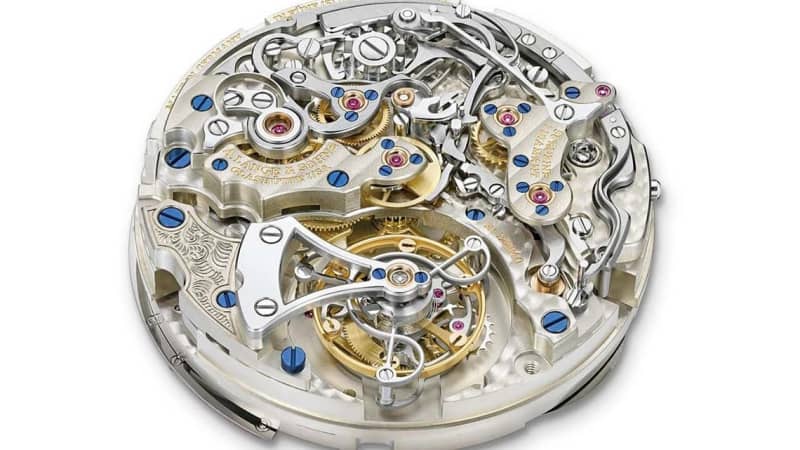
تتطلب مقارنة هذه الأنواع المختلفة من الحركات فحص عوامل مثل الدقة واستهلاك الطاقة والسعر.
على الرغم من أن الحركات الميكانيكية تحظى بالإعجاب في كثير من الأحيان بسبب براعتها وتصميمها المعقد، إلا أنها تتطلب عادةً صيانة منتظمة وقد تكون أقل دقة من نظيراتها الإلكترونية.
تشتهر الحركات الإلكترونية، وخاصة الكوارتز، بدقتها واستهلاكها المنخفض للطاقة، مما يجعلها خيارًا شائعًا للعديد من الساعات الحديثة.
ومع ذلك، فهي تفتقر إلى السحر والتراث المرتبط بالحركات الميكانيكية.
من حيث السعر، تميل الحركات الميكانيكية إلى أن تكون أكثر تكلفة بسبب بنيتها المعقدة والخبرة اللازمة لتصنيعها وصيانتها.
تعتبر الحركات الإلكترونية، وخاصة الكوارتز، أكثر بأسعار معقولة ويمكن الوصول إليها بشكل عام.
في النهاية، يعتمد الاختيار بين الحركات الميكانيكية والإلكترونية على حالة الاستخدام المقصودة والتفضيل الشخصي.
بالنسبة لأولئك الذين يقدرون البراعة الفنية والتقاليد في صناعة الساعات، قد تكون الحركة الميكانيكية هي الخيار المثالي.
وعلى العكس من ذلك، فإن الأفراد الذين يبحثون عن حل موثوق به ومنخفض الصيانة وفعال من حيث التكلفة قد يختارون الحركة الإلكترونية.
لاتخاذ أفضل قرار يناسب احتياجات الشخص واهتماماته، من المهم أن يكون لديك فهم شامل للتفاصيل والاختلافات الدقيقة لكل نوع من أنواع الحركة.
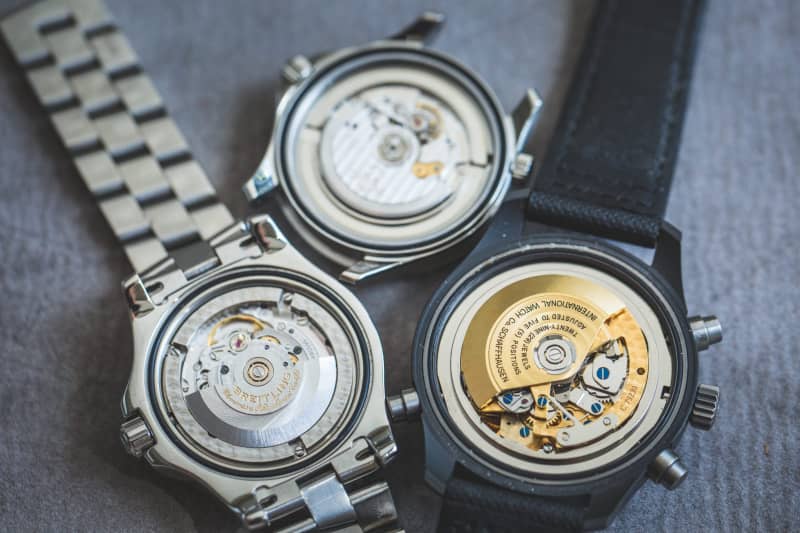
الشدات هي أدوات يدوية لا غنى عنها تستخدم في عالم الساعات والساعات.
يعتمد صانعو الساعات والساعات على مجموعة متنوعة من مفاتيح الربط للتعامل مع المهام المختلفة، مثل ضبط أو إزالة الصواميل والمسامير والمسامير.
تم تصميم هذه المفاتيح بدقة وعناية لضمان قبضة آمنة على المكونات المختلفة دون التسبب في أي ضرر.
تشمل الأنواع الشائعة من مفاتيح الربط مفاتيح مفتوحة النهاية، والتي تتميز بفكين متوازيين للإمساك، ومفاتيح قابلة للتعديل، والتي يمكن تعديلها لتناسب أحجام مختلفة من الصواميل والمسامير.
تلعب الملقط دورًا حاسمًا في العمل المعقد لإصلاح الساعة.
These small, precise tools are designed to manipulate and handle delicate components with utmost accuracy.
Clock and watchmakers use tweezers to carefully position, hold, and manipulate tiny screws, springs, and other delicate parts.
Tweezers come in various shapes, sizes, and materials, such as stainless steel or antimagnetic alloys, to suit different tasks and to ensure they do not cause any damage or magnetize sensitive components.
Loupe magnifiers are essential for the detailed examination and inspection of the clock and watch components.
These specialized magnifying devices are available in different magnification strengths, allowing clock and watchmakers to closely inspect and identify intricate details, such as markings, engravings, or hairline cracks on components.
Loupe magnifiers are typically small, handheld devices that offer precise and distortion-free magnification, enabling technicians to carry out intricate repairs and adjustments with heightened accuracy.
Testers are crucial tools used in clock and watch maintenance to assess and evaluate the performance and accuracy of timekeeping.
These devices come in various forms, such as timing machines or electronic testers, and allow clock and watchmakers to measure and analyze factors like accuracy, beat rate, amplitude, and power reserve.
Testers enable technicians to diagnose issues, fine-tune adjustments, and ensure the timekeeping accuracy of clocks and watches.
They are invaluable tools in maintaining the precision and reliability of timepieces.
Timekeeping irregularities pose a common challenge in the world of clock and watch repair, requiring skilled technicians to diagnose and rectify timing issues.
A variety of factors can contribute to these irregularities, such as misaligned or worn-out components, imbalances in the escapement mechanism, or even magnetic interference.
To tackle these issues, experienced repair professionals employ various techniques.
For instance, they may meticulously adjust the balance wheel’s poise or regulate the escapement to ensure precise timekeeping.
In scenarios where the timepiece runs too fast or slow, they may need to carefully manipulate the hairspring or make fine adjustments to the gear train.
Additionally, electronic timekeeping devices, such as quartz watches, might require battery replacement or recalibration to maintain accurate timekeeping.
Through their expertise and diagnostic tools, skilled technicians restore the precision of timepieces, ensuring they tick away with reliable accuracy.
Misaligned or damaged watch hands and dials often cause timepieces to be inaccurate and unappealing.
Clock and watchmakers employ several techniques to diagnose and fix these issues, relying on their experience, as well as special tools and equipment.
For example, experienced technicians use specialized tweezers, pliers, or jigs to carefully remove misaligned hands before replacing them with new ones.
Similarly, they might use loupe magnifiers to closely examine the dials for chips or markings before cleaning them up with a soft cloth.
In cases where the hands are stuck due to wear on the axle hole of the arbor or an accumulation of dirt, technicians must delicately adjust these components to free them up, before reinstalling and testing the restored parts.
Through their precision and expertise, clock and watchmakers can ensure that timepieces display accurate readings in an aesthetically pleasing manner.
Mechanical movements lie at the heart of clocks and watches, and repair technicians need to possess the expertise to identify and rectify issues with gears and springs.
These intricate mechanisms are susceptible to wear and damage over time, which can lead to timekeeping irregularities or complete malfunction.
Skilled professionals meticulously examine the gears, ensuring their alignment, proper lubrication, and tooth engagement. They may replace worn-out gears or repair damaged teeth to restore smooth and accurate movement.
Similarly, springs, such as the mainspring or hairspring, demand careful inspection and adjustment.
Technicians assess the tension, condition, and positioning of these springs, making necessary adjustments to achieve optimal performance.
The hairspring, in particular, requires delicate manipulation to ensure its concentricity and proper isochronism.
Through their expertise in identifying and rectifying gear and spring issues, repair technicians breathe new life into mechanical timepieces, enabling them to operate with the precision and reliability they were designed for.
Water resistance is a crucial feature in modern timepieces, protecting them from potential water damage.
However, over time, seals and gaskets may deteriorate or become compromised, compromising the watch’s water resistance.
Technicians who are skilled in watch repair have the necessary tools and knowledge to evaluate and repair the water resistance of watches.
The watch is thoroughly checked for any damage or wear that may affect its water resistance.
This includes examining the case, crown, pushers, and crystal. Seals and gaskets are also inspected and replaced if needed to ensure a secure seal.
In some cases, the watch may need to undergo pressure testing to verify its water resistance level.
Repair professionals not only fix watches but also educate owners on proper maintenance.
This includes regular checks and avoiding activities that exceed the watch’s water resistance rating.
Technicians assess and restore the waterproofing integrity to preserve the watch’s longevity and functionality. This gives watch owners peace of mind even in wet or aquatic environments.
Crystal and case repair is a delicate task, requiring precision and expertise.
Repair professionals must thoroughly inspect the crystal for any chips, scratches, or other damage that may be interfering with its clarity and appearance.
In cases of severe damage, technicians will need to replace the crystal entirely to restore the watch’s aesthetic appeal.
Similarly, they assess and analyze the condition of the watch case, verifying its alignment and any signs of wear.
Parts such as the bezel, crown tube, and stem are inspected thoroughly for any loose screws or misalignment issues.
If necessary, these components can be replaced or readjusted for better performance.
Additionally, technicians may refinish or polish casings to restore their original luster.
Repair professionals also take special care to ensure that all gaskets are snugly installed in their respective grooves before sealing them securely with silicone grease or adhesives.
This extra step ensures a tight seal between the caseback and crystal so that water won’t leak inside the watch’s movement.
Technicians can maintain a timepiece’s precision performance and aesthetic integrity by ensuring accuracy in both crystal replacement and case repair processes.
The power source is an important component of a watch and its performance.
Battery replacement is one of the tasks performed by repair technicians to maintain accuracy and reliability in timepieces.
A technician must have the necessary tools and expertise to open a watch caseback, safely remove the battery, and replace it with a new one.
They must also inspect the contacts and terminals for any signs of corrosion or damage before replacing the battery.
In some cases, the watch may suffer from internal faults that require more advanced troubleshooting methods than just replacing the battery.
Through careful observation and analysis, technicians can identify such faults and then determine if they require further repairs or replacement parts for proper functioning.
In addition to batteries, technicians may also need to fix or replace other power sources like solar cells or automatic movements in certain watches.
Watch repair professionals ensure that timepiece owners always get accurate timing from their watches by offering prompt and efficient solutions to battery-related problems.
Watch bands and bracelets are important components of a timepiece, providing comfort and support while wearing the watch.
However, they can become damaged or worn over time due to regular use or environmental factors such as humidity or temperature changes.
To maintain optimal performance and appearance, it’s essential to regularly inspect these components for any signs of wear or damage.
For those who don’t have the skill set required to perform band/bracelet repairs themselves, professional watch repair technicians provide a valuable service by ensuring that these parts are in good condition at all times.
They adjust straps so they fit snugly on the wrist without feeling too tight or loose:
Complications and functions are the more advanced features of a watch, including chronographs, alarms, calendars, split-second hands, and moon phase indicators.
Repair technicians must be knowledgeable about these complex components to diagnose any issues and restore them to their proper functioning state.
They assess the watch’s condition by testing its various features for accuracy and functionality.
Through careful troubleshooting, they identify problems such as inaccurate timekeeping or incorrect display information.
Then, using specialized tools and parts, they dismantle each component carefully before replacing any damaged parts or repairing worn-out mechanisms.
Finally, technicians reassemble all components into place before verifying that the watch is accurately keeping time and displaying all information accurately.
Lubrication and cleaning are essential aspects of watch repair, as it ensures the smooth movement and longevity of the timepiece.
A technician must have a thorough knowledge of how to properly lubricate delicate components like wheels, cogs, and gears with precision oils.
Cleaning is also an important step to keep dust and dirt particles from entering the watch’s mechanism and causing wear or damage.
By brushing away dirt buildup on the caseback or bracelet links, technicians can ensure that these parts are in good condition.
Furthermore, they use ultrasonic cleaners to remove any debris from internal parts such as dials, hands, springs, and escapements.
With proper lubrication and cleaning techniques, a technician can restore the functionality and accuracy of a watch while maintaining its aesthetic beauty for years to come.
Vintage timepieces require special care and attention when it comes to repair.
Expert watchmakers must be highly knowledgeable about the mechanics of antique clocks and watches, with extensive experience in handling these delicate items.
They must also possess the right tools for disassembling and reassembling complex components without causing any damage to them.
Also, they need to understand how the internal mechanisms operate to identify any problems and properly diagnose the issue.
Vintage watch repair technicians often have access to rare parts that are not available on the market today, which allows them to restore these valuable items to their original state.
With patience, dedication, and skillful craftsmanship, expert technicians can ensure that vintage timepieces retain their timeless beauty for many years to come.
Watch recycling and refurbishment is a complex process that requires expertise and precision.
It involves the disassembly of the watch while preserving all parts, movement repair and replacement with high-quality spare parts, dial modification and restoration while preserving the original design, and waterproofing testing to ensure that the watch functions properly.
This process allows for watches to be recycled in an eco-friendly way, allowing them to be enjoyed for years to come.
Recycling watches is beneficial in many ways.
Not only does it help reduce waste, but it also allows people to enjoy luxury watches without having to purchase new ones.
Additionally, by recycling watches, you can save money on buying a new one while still getting the same quality product.
Refurbishing watches also helps preserve their original beauty as well as their functionality.
When it comes to watching recycling and refurbishment, some best practices should be followed.
By following these best practices when recycling or refurbishing watches, you can help reduce waste while still enjoying luxury timepieces at a fraction of their original cost.
Additionally, you can help preserve their original beauty while ensuring they remain functional for years to come.
إن الآلية المعقدة لكل ساعة هي عمل فني. كل ساعة فاخرة لها مستوى من الحرفية والجودة. تم إنشاء كل منها فنيًا بواسطة صانعي الساعات الخبراء مما يجعل الساعة ذات تصميم أنيق ودقة في ضبط الوقت. لكن جامعي الساعات الفاخرة يفضلون الحركات الميكانيكية أو الأوتوماتيكية. اسمح لنفسك بالانخراط في أحد أنواع حركة الساعة وشارك أفكارك أدناه إذا كانت لديك رؤية مختلفة!
لن يتم نشر عنوان بريدك الإلكتروني. الحقول المطلوبة مشار إليها *

حقوق الطبع والنشر © 2018 سوفلي المحدودة
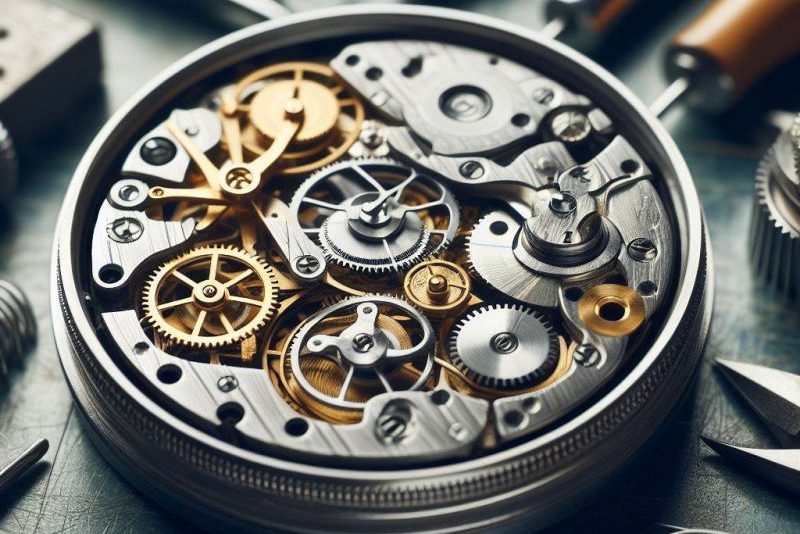
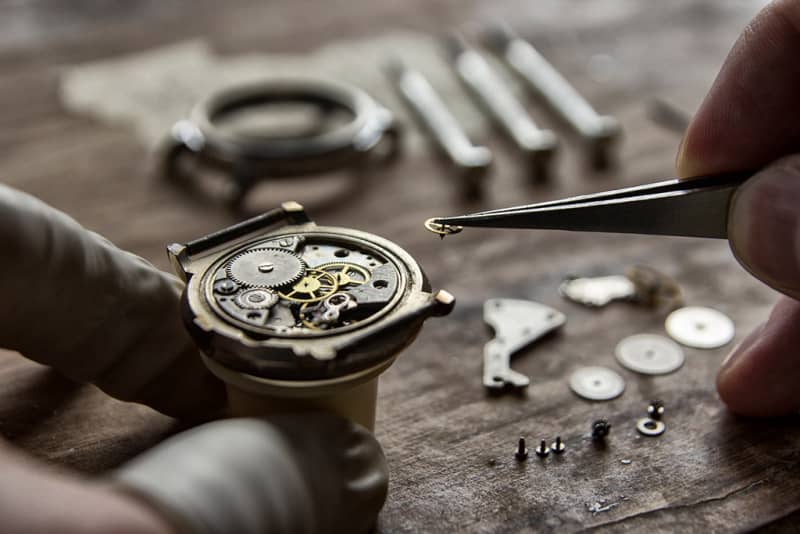
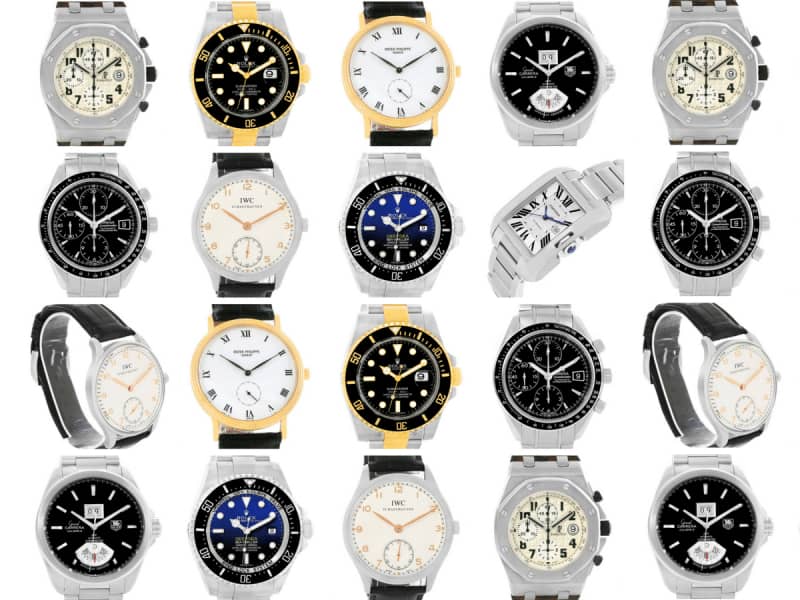
I find it surprising that you could use watch repair to help maintain your timekeeping devices and prolong their lifespan. My friend inherited a couple of pieces from his aging grandpa and a huge grandfather’s clock. I should talk to him about finding a clock shop that can help him with this someday.